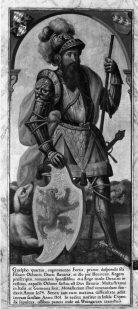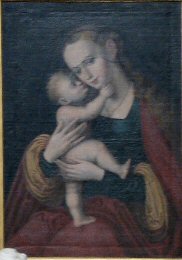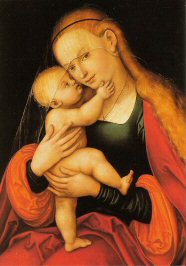The largest baroque basilica in Germany
In 1715 the Romanesque basilica was demolished and the foundation stone for the new building was laid in the same year. In 1717 the vaults could already be moved in. In 1718, Franz Xaver Schmuzer from Wessobrunn began with the stucco work and Cosmas Damian Asam with the frescos. Both completed their work in 1720. 10 September 1724 the church was consecrated by the bishop of Constance, Count Schenk von Stauffenberg.
Pilgrims enter the Benedictine monastery through the "back entrance" and first discover the Guelph lion.
The heraldic animal of the Guelphs reminds us that Altdorf-Weingarten of the 11th century was the ancestral seat of this noble family,
which has shaped the history of Europe for centuries and still lives on in the houses of Hanover and Windsor.
In 1056 Welf IV founded the Benedictine monastery as a family tomb and in 1094 he donated a holy-blood relic which had been found in Mantua in northern Italy.
The Welfish Foundations have shaped the development of Weingarten to this day.
Here in Weingarten stands a bronze replica of the Braunschweig Lion, 12th century.
In the same courtyard there is also this sign.
Still 2400km to Santiago. Here I stood already once, when I was on my bike - move the mouse over the picture!
This is the impressive front of the baroque church. Already in the 12th century monks built a three-nave columned basilica here on the site of a smaller church, modelled on the cathedral of Reichenau - Mittelzell.. This Romanesque building was consecrated in 1182 and served the monks as a place of worship until the new building was constructed in the Baroque period. Today, parts of the south wall, the transept and the south tower are still preserved.
In the base of the altar table (zoom with the + key) there is the Holy Blood Relic
This is earth from Mount Golgotha soaked with the blood of Christ. According to a Legend the converted Roman captain Longinus brought it to Mantua. There, in 1048, the relic was divided between the city of Mantova, Pope Leo IX and Emperor Henry III. The latter donated his precious share to Count Balduin of Flanders as a gift, who in turn bequeathed it to his daughter Judith.
Judith became the wife of Welf IV. (in second or third marriage - I could not find out). Welf IV gave the relic to the monastery.

This is what Welf IV looked like:
Panel from a provost's table (1585-1802) from Rottenbuch, a former Augustinian canon monastery 'St. Maria', which was also founded by Welf IV.
The Benedictine monastery Weingarten was founded in 1056 by Welf IV as the burial place of the Guelph dynasty.
Twelve members of the Guelph family were buried in the monastery church; the last was Henry the Black (+1126, Ravensburg), the father of Henry the Proud and grandfather of Henry the Lion.
Originally, the burial place was under the former Holy Blood Altar, which was also located here. During the Baroque reconstruction of the monastery church (1724), the burial ground was redesigned.
In 1852, on the occasion of a visit to his ancestors in Weingartner, King George V of Hanover provided the funds for a new construction of the tomb, which was built in 1859 in the Neo-Romanesque style.
Joseph Gabler built the organ in 1737-1750 around the six windows so that light could still enter the church.
In 1983 the organ was restored by organ builder Th. Kuhn AG (Männedorf on Lake Zurich).


Weingarten has an exceptionally beautiful copy of the Mariahilfbild (dark picture), which is very much revered here.
Unfortunately my photo is not so well done.
The veil, which is difficult to paint, is beautifully executed here.
See also: Reflections on the Mariahilfbild
Comparison: The original by Lucas Cranach in Innsbruck
The group of pilgrims in front of the basilica

